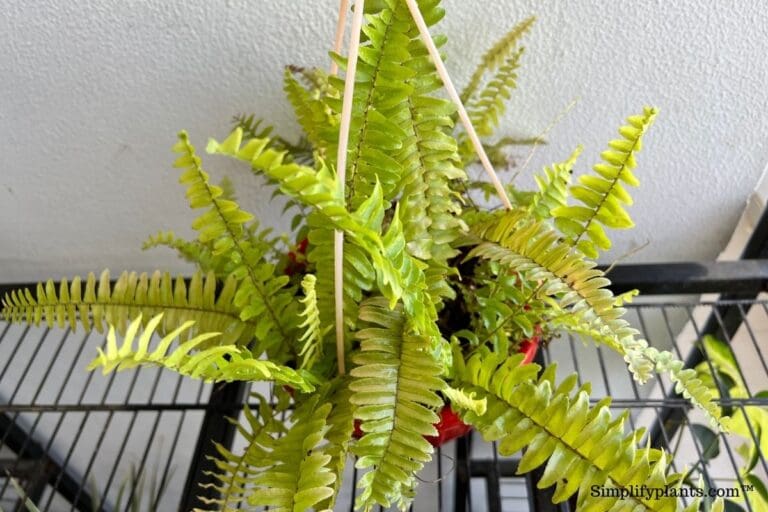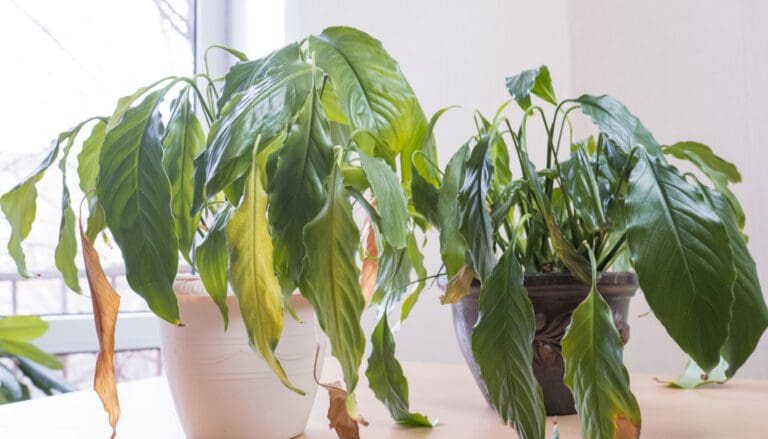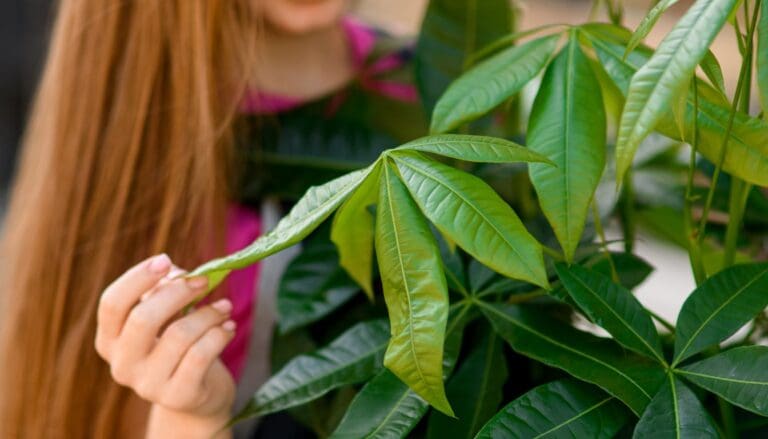10 Easy Steps To Save An Overwatered Chinese Evergreen
Overwatering is common among houseplants, and Chinese evergreen is no exception. Frequent watering and wrong soil type mostly cause this issue.
Chinese evergreens love moisture and demand their soil to be moist, but if you drench the soil with water to show extra love, you’ll overwater it.
Overwatering can have different stages of damage. But don’t worry; if the damage is not too severe, it is curable.
So, in this article, we shall learn how do you save an overwatered Chinese evergreen.
Here are a few ways to fix an overwatered Chinese evergreen plant:
- Avoid watering too frequently and let the topsoil dry out.
- Take the plant out of the pot and inspect for any damage.
- Trim off the damaged leaves and roots.
- Use a new pot to repot the plant. Make sure the pot has adequate drainage holes.
- Choose a well-draining soil mix for your plant.
- Maintain a flexible watering schedule where you check the soil once a week and water the plant only if the top layers are dry.
- Keep the plant in a brightly lit spot.
We have mentioned some remedies to fix an overly watered Chinese evergreen. Keep reading the article to know more about the fixes, signs, and causes of overwatering.

Please note: Simplify Plants is reader-supported. Some links in the post are affiliate links and I get a commission from purchases made through links in the post.
What are the signs of an overwatered Chinese evergreen plant?
Identification of the initial signs of damage helps to take essential steps. Damages are curable when identified at an early stage.
The signs of an overwatered Chinese evergreen plant are:
- Soggy soil
- Yellowing of leaves
- Weak stems
- Brown foliage
- Wilted leaves
- A stinky smell emitted from the soil
- Reduced growth rate or no growth
- Dropping of leaves
- Edema
- Growth of white mold on the soil
- Soft brown roots
Stinky soil confirms root rot. Root rot is severe and might kill your plant if not treated properly. But don’t worry, we have mentioned how to fix all the stages of an overwatered Chinese evergreen.
Different signs at different stages of overwatering
The signs of overwatering can be similar to underwatering to some extent. Inspect carefully to distinguish between them.
Both the conditions might look the same, but the remedies are different. So, we will briefly describe the difference between the two and the different stages of overwatering in a Chinese Evergreen.
The following are some damage signs shown by plants at different stages of overwatering.
Wilted leaves
Wilted leaves are a stress sign shown by plants when they are soaked with water or kept dry for long. So, inspect the plant to make sure that it is overwatering you’re dealing with.
Use a moisture meter or simply your finger to check the soil. If the moisture content is below 25%, the plant is underwatered, and if it’s more than 70%, it is overwatered.
Take note that wilted leaves appear at the probable first stage of overwatering.
Color or texture change in leaves

Yellow leaves are typical when your plant is overwatered. This is one of the early signs of overwatering.
However, if you notice brown or black leaves, the plant might have reached advanced stages of overwatering, possibly even root rot.
High moisture in the soil
Without any technical knowledge, if you want to know your plant’s moisture content, just stick a finger inside the soil and check if it’s wet or dry.
The color of soil also determines the water content. Dark brown soil suggests a high moisture content, while light brown crumbly soil indicates dryness.
The ideal watering condition is when 50% of the soil is dry, and the excess water has drained out. But if the moisture content feels high when you look at the soil or touch it, you have an overwatered plant.
Dropping of leaves
This occurs in the last stage of overwatering. But it can even happen in a severely underwatered plant. Old leaves or the new ones drop when they experience unsuitable conditions.
To know the exact cause of why the leaves are dropping, check the soil.
This is an alarming sign. If not cured, it will lead to the death of the Chinese evergreen.
What are the causes of overwatering in Chinese evergreen?
The clear answer to overwatering cause is frequently watering the Chinese evergreen plant. But, this is not the only reason. Other reasons can also contribute to overwatering.
Frequent watering

Frequent watering without checking the soil moisture is the most common cause that deteriorates the plant’s health. Although aglaonema loves being in evenly moist soil, you should never water excessively.
Watering too frequently or before the topsoil is dry and ready for it causes overwatering.
In general, a Chinese evergreen requires watering once in 7-10 days. However, following a routine blindly without checking the soil’s moisture level can also cause overwatering.
Also read: How Much Water Does A Chinese Evergreen Need? (How Often+Summer & Winter)
Wrong potting soil
The ideal soil mix for Chinese evergreen is one that not only retains moisture but also drains the excess water.
If you choose too heavy soil that doesn’t support drainage, the Chinese evergreen will get overwatered even when you water it correctly. If you suspect this to be the reason for the overwatering, you can mix some sand or perlite with the soil.
You can also repot the Chinese evergreen with a fresh potting mix that contains the right proportion of elements that support both retention and drainage.
Also read: What Kind Of Soil Does A Chinese Evergreen Need? (+Best Soil Mix)
Poor drainage system
Pots with poor drainage structures cause overwatering. Excess water gets accumulated around the roots of the plant. They further clog the areas that supply air to the soil particles.
The amount of oxygen required for the roots to function gets cut off. Insufficient oxygen and too much moisture in the soil lead to root rot.
You must never use a pot that doesn’t have drainage holes. You must also empty the cache tray frequently to avoid overwatering.
Pot material

Pots made with organic materials absorb excess water due to their porous nature. Clay pots or terracotta pots are porous, so they absorb excess water from the soil and allow proper airflow.
Plastic, ceramic, cement, or glass pots don’t allow free movement of air from their surface. Water also accumulates in the soil due to its non-permeable nature.
You should water your Chinese evergreen depending on the pot material.
A Chinese evergreen living in a plastic pot will require less water as the water will take longer to dry up. But if it is planted in a terracotta pot, the water will dry up faster, so the plant will require more water.
Not keeping the pot material in mind while watering your Chinese evergreen can also lead to overwatering.
Also read: What Kind Of Pot For Chinese Evergreen? (Pot type, Size, Material & More)
Size of the pot
A large pot requires more soil, which will hold more moisture. Plants that are smaller in size need relatively less water. After watering, they will take more time to absorb all the water from the soil.
The soil will remain soggy for a longer time, causing overwatering.
Always choose a pot that will complement the size of your Chinese evergreen. It should be at least 1-2 inches more in diameter than the diameter of your plant.
But be careful. Pots too small in size can also lead to a rootbound plant.
External temperature and weather
Not changing the watering routine in winter can cause overwatering.
Your Chinese evergreen goes into a dormant state in winter due to the low temperature and less sunlight. Since it doesn’t remain active, it doesn’t require as much water as the other seasons.
The soil also takes longer to dry due to the low-intensity light and low temperatures. So, you must avoid watering as frequently during winter.
Also read: How Cold Can Chinese Evergreens Tolerate? (Chinese Evergreen Cold Tolerance)
Humidity

Chinese evergreen is a tropical plant, so you can understand that it will require high humidity. However, the rate of humidity and capacity of soil to absorb moisture is inversely proportional.
The more the humidity in the atmosphere, the less the soil will absorb water.
If you already have a source of humidity for your plant (humidifier, pebble tray technique, or misting), reduce the watering frequency.
Watering too much when you already have a systematic way to provide humidity to your plant can cause overwatering.
Also read: Should I Mist My Chinese Evergreen? (+Humidity Guide)
How to fix an overwatered Chinese evergreen?
The first action is to prevent further damage by stopping the watering. Let your plant dry out all the moisture from the soil. At least 50% of the soil should be dry before watering.
Most houseplants love moist soil but hate staying wet. Check the soil by inserting your finger one inch into the soil. If it feels wet on the full finger, do not water it again. And if it feels dry, water it.
You can use a moisture meter for more technical and accurate knowledge of the soil moisture level.
Here are some ways to fix an overwatered Chinese evergreen.
- Stop watering immediately to avoid further deterioration. If you keep watering an overwatered plant, you significantly damage it.
- Let the plant dry out naturally. Turn off the humidifier, if any. This may accelerate the process.
- Tilt the pot a little bit to drain out the excess standing water.
- Clean the drainage holes below the pot if they are clogged. Clogged holes cannot drain out those excess water.
- Place your plant in a less humid area. Humidity decreases the rate of transpiration. Excess water in the plant can dry out through stomata.
- Keep your plant in a bright area under the indirect sun until the soil dries up completely. You must avoid direct sunlight or scorching heat, which can cause more harm.
- Allow a proper passage of air in the soil. Air helps to dry out the soil faster. A good flow of air provides sufficient oxygen and air to the soil.
- Avoid fertilizing your Chinese evergreen till it’s healthy again. We know fertilization is essential as it provides nutrition to the plant. But fertilizing an already damaged plant will waste the fertilizer or harm your plant even further. Avoid fertilizing until your plant completely recovers.
- Prune the damaged leaves as they are not going to turn healthy. Yellow and brown leaves are common signs of overwatering. Trim those damaged leaves with a pair of sharp, disinfected scissors. The plant can focus on growing and nourishing new leaves rather than wasting its energy on the damaged ones.
- Don’t hesitate to change soil if it’s an issue. Incorrect soil type also causes overwatering. Some soil types have a low water-holding capacity, while some have more.
The ideal soil type for Aglaonema is slightly acidic potting soil with perlite.
If the soil you are using fails to hold moisture, then mix some sand or mulch in it. These two ingredients will increase the absorbing capacity of the soil that you are using.
Root rot

One of the most deadly diseases that overwatering can cause is root rot. In this situation, your plant’s roots will emit a stinky smell, turn dark brown, and feel soft when touched.
The signs of root rot are:
- Stinky soil
- Soft and deep brown roots
- Falling leaves
- No growth
- Wilted plant
- Mold
How to fix root rot in a Chinese evergreen?
Here are some steps to cure root rot in your Chinese evergreen.
- Take out the Chinese evergreen from its pot and inspect the roots.
- Shake your plant gently to remove the excess soil from the roots. You can also wash it, but be careful during the entire process. Don’t harm the healthy roots.
- Take a pair of sharp scissors and disinfect them with rubbing alcohol.
- Now prune off all the rotten roots. Also, prune the damaged leaves.
- Take a fresh pot, fill it with a freshly prepared potting mix.
- Add fresh soil to the pot and plant your Chinese evergreen carefully.
- After repotting, keep your Chinese evergreen under a bright indirect light. Maintain a temperature between 68-77°F.
The recovery of your Chinese evergreen depends on how much it is damaged. It also depends on the process of treatment and care. So don’t mistake watering without checking the soil’s moisture.
Always remember, water your Chinese evergreen only when it is needed. Avoid excess watering to show love.
It is better you underwater your Chinese evergreen than overwater as it can get challenging to fix an overwatered plant. However, you can fix it with the steps I have mentioned in this article.

Reference: Wikipedia, Nasa clean air study, Missouri Botanical Garden, The University of Kansas, NC State University.
Recommended Garden Supplies
| Product Image | Our Recommended Gardening Supplies | Check Offers! |
|---|---|---|
Top Top
Top
Top
Top
Top
Top
Top
Top | rePotme Houseplant and Tropical Classic Potting Soil Mix | Check Offer On Amazon |
 Top
Top
Top
Top
Top
Top
Top
Top | Espoma Organic Indoor Plant Food | Check Offer On Amazon |
 Top
Top
Top
Top
Top
Top
Top
Top | GooingTop LED Grow Light 6000K Full Spectrum Clip Plant Growing Lamp | Check Offer On Amazon |
 Top
Top
Top
Top
Top
Top
Top
Top | Soil Moisture Meter | Check Offer On Amazon |
 Top
Top
Top
Top
Top
Top
Top
Top | Govee Hygrometer Thermometer, Bluetooth Enabled! | Check Offer On Amazon |
 Top
Top | LEVOIT Humidifiers for Large Room(Best For Plants) | Check Offer On Amazon |
 Top
Top
Top
Top
Top
Top
Top
Top | Upgraded DIY Automatic Drip Irrigation Kit, 15 Potted Houseplants Support | Check Offer On Amazon |
 Top
Top
Top
Top
Top
Top
Top
Top | Stainless Steel Heavy Duty Gardening Tool Set | Check Offer On Amazon |
 Top
Top
Top
Top
Top
Top
Top
Top | Bonide Insecticidal Soap | Check Offer On Amazon |
 Top
Top
Top
Top
Top
Top
Top
Top | Bonide 32 oz Spray Neem Oil for Organic Gardening | Check Offer On Amazon |
 Top
Top
Top
Top
Top
Top
Top
Top | Garden Safe Fungicide | Check Offer On Amazon |







Thanks this was helpful! I had a Chinese evergreen at the office and I would water it every week and although the office was dry it was thriving! Then I think someone else started watering it too because now it has root rot. After cutting the bad parts off, I thought I would place it water to see if it can produce more roots before I place in potting soil again, is this a good idea or bad?
Hey there!
So sorry to hear about your Chinese evergreen! Giving it a fresh start in water is a smart move. Just make sure to keep the water clean and only submerge the base of the stem, not the leaves. Once you see new roots, you can transition it back to potting soil. Keep an eye on the watering once it’s back in the office to prevent a repeat. Fingers crossed for a full recovery!
Rooting for your plant’s comeback! 🌱💧